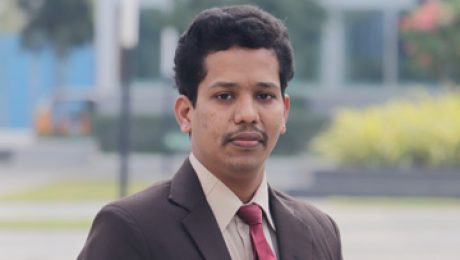Engineering the art of discovering similar song patterns
The power of merging art with science is beyond our imagination. This amalgamation can pull off things that may seem insurmountable without the assistance of the other. Professor Hiren Deva Sarma, Guest faculty of the Department of Computer Science and Engineering, has developed a computational technique to find the similarity between the given songs in a pool. His paper titled An Approach to Discover Similar Musical Patterns has been published in IEEE ACCESS, a Q1 journal with an impact factor of 3.36.
Abstract
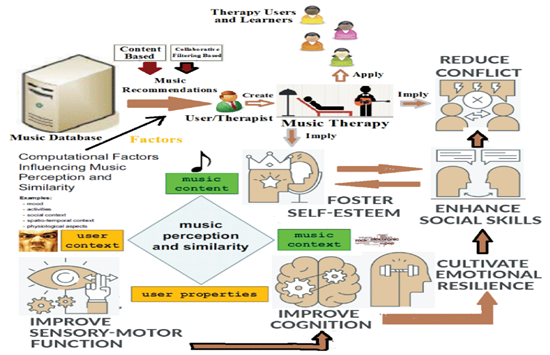 An algorithm has been developed to find the similarity between given songs. The song pattern similarity has been determined by knowing the note structures and the fundamental frequencies of each note of the two songs under consideration. The statistical concept, Correlation of Coefficient, is used in this work. The correlation of Coefficient is determined by applying the 16 Note-Measure Method. If the Correlation of Coefficient is near 1, it indicates that the patterns of the two songs under consideration are similar. Otherwise, there exists a certain percentage of similarity only. This basic principle is used in a set of Indian Classical Music (ICM) based songs. The proposed algorithm can determine the similarity between songs, so alternative songs in place of some well-known songs can be identified in terms of the embedded raga patterns. A digital music library has been constructed as a part of this work. The library consists of different songs, their raga name, and their corresponding healing capabilities in terms of music therapy. The proposed work may find application in the area of music therapy. Music therapy is an area of research that has been explored significantly in recent times. This work can also be exploited for developing an intelligent multimedia tool applicable in the healthcare domain. A multimedia-based mobile app has been developed encapsulating the abovementioned idea that can recommend alternative or similar songs to the existing ICM-based songs. This mobile app-based music recommendation system may be used for different purposes, including entertainment and healthcare. As a result of the applications of the proposed algorithm, similar songs in terms of raga patterns can be discovered from within the pool of a set of songs. A Music Recommendation System built on this algorithm can retrieve an alternative song from within the pool of songs as a replacement to a well-known song, which otherwise may be used for particular music therapy. Results are reported and analysed thoroughly. The future scope of the work is outlined.
An algorithm has been developed to find the similarity between given songs. The song pattern similarity has been determined by knowing the note structures and the fundamental frequencies of each note of the two songs under consideration. The statistical concept, Correlation of Coefficient, is used in this work. The correlation of Coefficient is determined by applying the 16 Note-Measure Method. If the Correlation of Coefficient is near 1, it indicates that the patterns of the two songs under consideration are similar. Otherwise, there exists a certain percentage of similarity only. This basic principle is used in a set of Indian Classical Music (ICM) based songs. The proposed algorithm can determine the similarity between songs, so alternative songs in place of some well-known songs can be identified in terms of the embedded raga patterns. A digital music library has been constructed as a part of this work. The library consists of different songs, their raga name, and their corresponding healing capabilities in terms of music therapy. The proposed work may find application in the area of music therapy. Music therapy is an area of research that has been explored significantly in recent times. This work can also be exploited for developing an intelligent multimedia tool applicable in the healthcare domain. A multimedia-based mobile app has been developed encapsulating the abovementioned idea that can recommend alternative or similar songs to the existing ICM-based songs. This mobile app-based music recommendation system may be used for different purposes, including entertainment and healthcare. As a result of the applications of the proposed algorithm, similar songs in terms of raga patterns can be discovered from within the pool of a set of songs. A Music Recommendation System built on this algorithm can retrieve an alternative song from within the pool of songs as a replacement to a well-known song, which otherwise may be used for particular music therapy. Results are reported and analysed thoroughly. The future scope of the work is outlined.
Explanation of the research
A computational technique has been developed to identify a particular song similar to another in terms of its embedded raga pattern. Indian Classical Music (ICM) based songs are considered in this work. As a result of the application of the proposed technique, it is possible to identify similar songs in terms of their raga patterns from within a pool of songs. Subsequently, a similar alternative song can be recommended for different applications, including music therapy. If we consider music therapy, an alternative medicine (note: here, medicine is the song) is possible to recommend due to the proposed technique. This algorithm will find many applications in the domain of music information retrieval (MIR) and music recommendation systems (MRS).
Practical implementation of the research
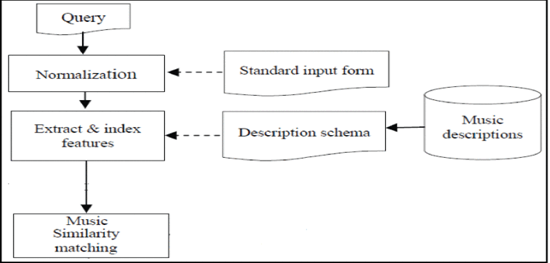 This algorithm may be applied in recommending music in music recommendation systems. Moreover, music information retrieval based on raga patterns can be an important domain where the proposed algorithm may be exploited. Considering the social implications, music therapy has been the intended area of the research; therefore, this algorithm has been developed considering numerous applications of music therapy based on Indian Classical Music. The music therapy community will be benefited from the proposed algorithm.
This algorithm may be applied in recommending music in music recommendation systems. Moreover, music information retrieval based on raga patterns can be an important domain where the proposed algorithm may be exploited. Considering the social implications, music therapy has been the intended area of the research; therefore, this algorithm has been developed considering numerous applications of music therapy based on Indian Classical Music. The music therapy community will be benefited from the proposed algorithm.
In this research project, Professor Hiren Deva Sarma has collaborated with; Assistant Professor Sudipta Chakrabarty, Techno India, Salt Lake at the Department of Master of Computer Application; Mr Ruhul Islam, IT Consultant, Cloud Shine Global LLP; and Emil Pricop, Associate Professor in the Department of Automatic Control, Computers and Electronics, Petroleum-Gas University of Ploiesti, Romania.
In the future, the researchers look forward to exploring the music therapy capabilities of Indian Folk Music (IFM) like Kamrupia Lokgeet, Goalparia Lokgeet, and Baul Geet. Understanding the similarity and dissimilarity of the above-mentioned folk songs with Indian Classical Music (ICM) from computational musicology perspectives is another objective of the proposed research work. The researchers also aim to develop Music Recommendation Systems (i.e., applications) considering the songs mentioned above (ICM + IFM) and the different requirements of the users.
- Published in CSE NEWS, Departmental News, News, Research News
Enhanced dynamic performance in DC-DC converter-PMDC motor combination
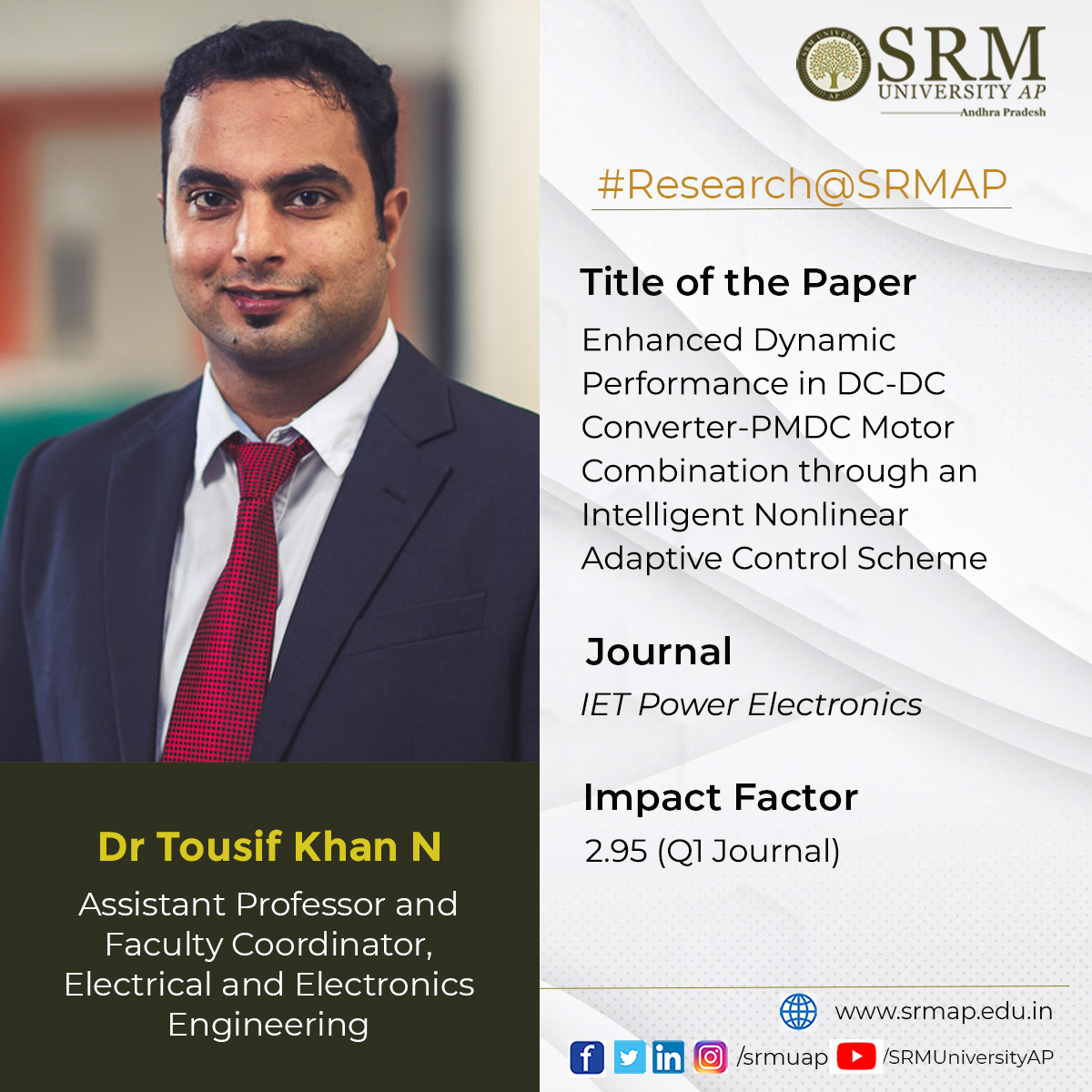 “Enhanced Dynamic Performance in DC-DC Converter-PMDC Motor Combination through an Intelligent Nonlinear Adaptive Control Scheme”, is the latest paper published by Dr Tousif Khan, Assistant Professor of EEE Department at SRM University-AP in the reputed IET Power Electronics (Q1 journal) having an Impact Factor of 2.95.
“Enhanced Dynamic Performance in DC-DC Converter-PMDC Motor Combination through an Intelligent Nonlinear Adaptive Control Scheme”, is the latest paper published by Dr Tousif Khan, Assistant Professor of EEE Department at SRM University-AP in the reputed IET Power Electronics (Q1 journal) having an Impact Factor of 2.95.
Abstract
A novel neuro-adaptive control scheme is proposed in the context of angular velocity tracking in DC-DC buck converter-driven permanent magnet DC motor system. The controller builds upon the idea of backstepping control. The proposed method guarantees a rapid recovery of nominal angular velocity tracking under parametric and non-parametric uncertainties. In order to verify the performance of the proposed neuro-adaptive speed controller, extensive experimentation has been conducted in the laboratory under various real-time scenarios. Results are obtained for start-up, time-varying angular velocity tracking and under the influence of highly non-linear unknown load torque. The performance metrics such as peak undershoot/overshoot and settling time are computed to quantify the transient response behaviour. The results clearly substantiate theoretical propositions and demonstrate an enhanced dynamic speed tracking under a wide operating regime, thus confirming the suitability of the proposed method for fast industrial applications.
- Published in Departmental News, EEE NEWS, Research News
Twisted conjugacy in linear algebraic groups
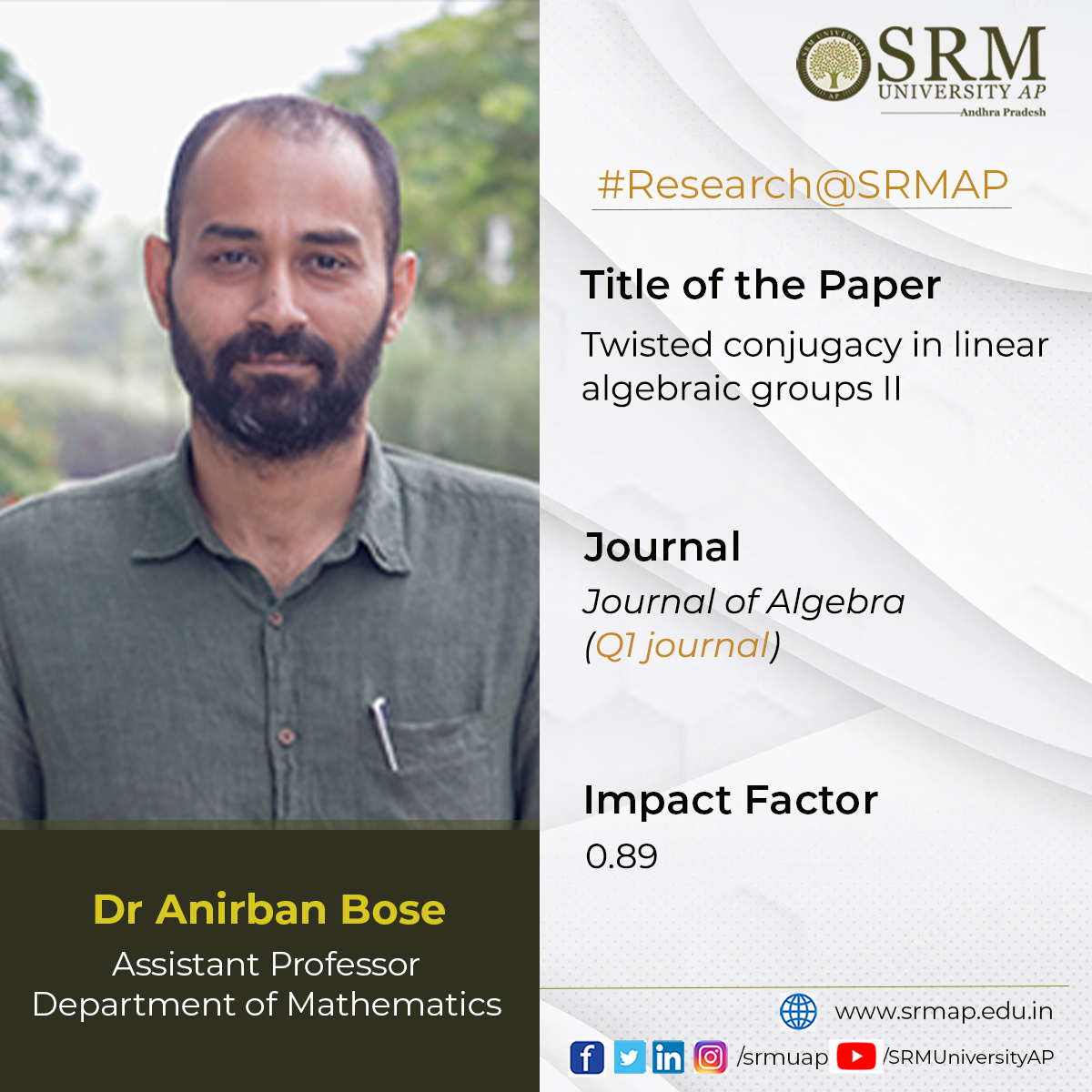
The Department of Mathematics is glad to announce that Dr Anirban Bose, Assistant Professor, has published an article, ‘Twisted conjugacy in linear algebraic groups II’ in the Q1 journal, Journal of Algebra. The paper was published in collaboration with Sushil Bhunia from Indian Institute of Science Education& Research, Mohali. The present work and its prequel “Twisted conjugacy in linear algebraic groups” are concerned with computing the number of orbits of a twisted conjugacy action of an algebraic group on itself. Dr Bose’s interests mainly lie studying the properties of groups of matrices.
Here’s the link to the article.
- Published in Departmental News, Math News, News, Research News
Deep learning enabled IRS for 6G intelligent transportation systems
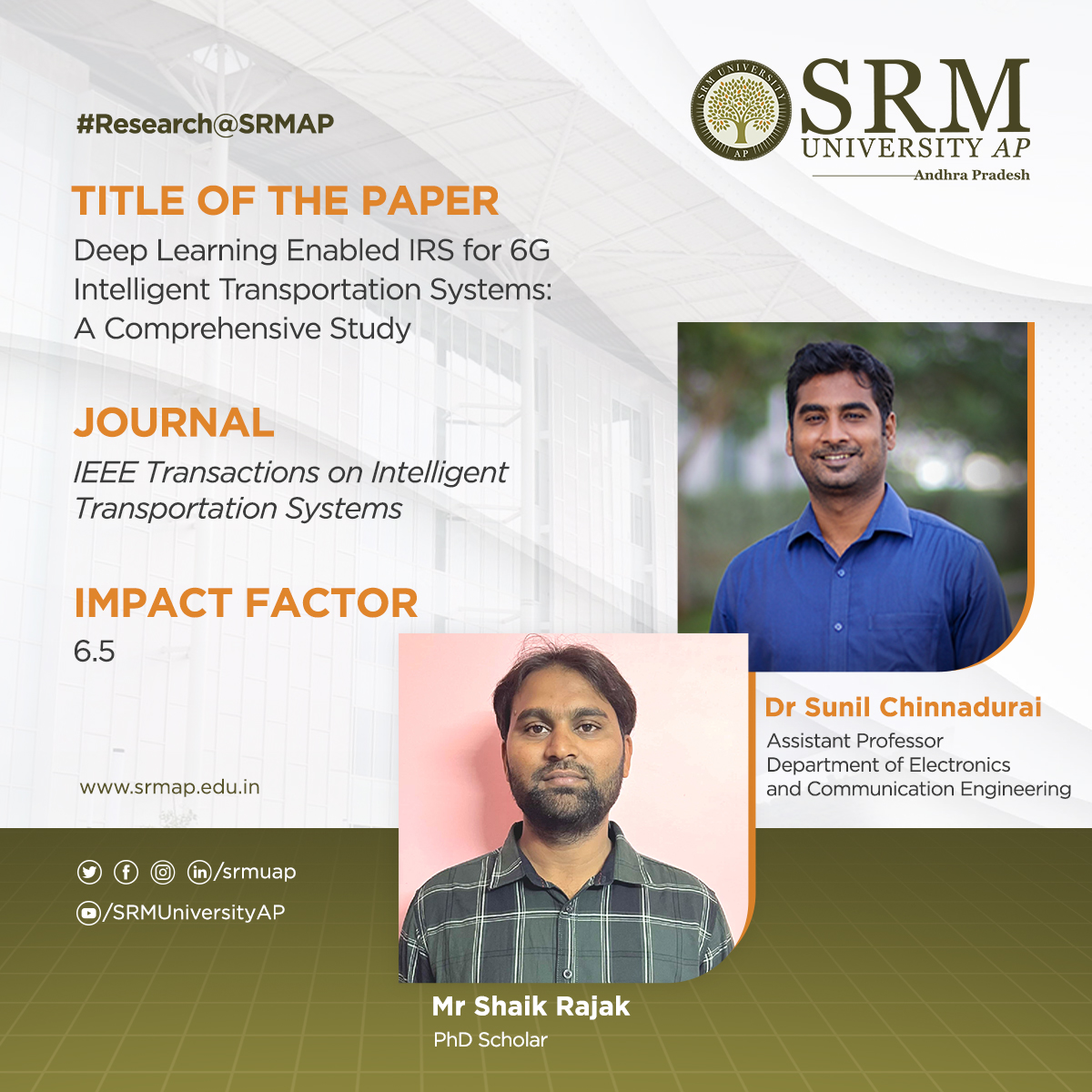
Intelligent Transportation System (ITS) is on its way to becoming the biggest player in the coming-of-age transportation system. However, the sheer demand for the enormous amount of data to secure seamless connectivity and functioning with maximum speed and safety tends to increase the power consumption of the ITS. Dr Sunil Chinnadurai and his PhD scholar Mr Shaik Rajak from the Department of Electronics and Communication Engineering present Intelligent Reflecting Surfaces (IRS) as the key enabling technology to provide the data required by the ITS with less power consumption.
Their article “Deep Learning Enabled IRS for 6G Intelligent Transportation Systems: A Comprehensive Study” which makes a comprehensive study on the DL-enabled IRS-aided ITS was published in the esteemed journal ‘IEEE Transactions on Intelligent Transportation Systems’ having an Impact factor of 6.5. The article elucidates the ways and means to overcome the channel estimation, secrecy rate, and energy efficiency optimisation problems.
The research suggests that connecting ITS to wireless networks via IRS will help in reaching the destination within the stipulated time duration with enhanced safety and comfort. Besides highlighting the reduced power consumption and hardware cost of the DL-enabled IRS-aided ITS, the article also projects that IRS usage in 6G-ITS massively helps the traffic control system to precisely send and receive the information of school buses as well as healthcare vehicles like ambulances, fire safety vehicles, etc. Their future research plans also include the experimental analysis of energy efficiency for wireless networks and Intelligent Transportation Systems with IRS.
Abstract of the Research
Intelligent Transportation Systems (ITS) play an increasingly significant role in our life, where safe and effective vehicular networks supported by sixth generation (6G) communication technologies are the essence of ITS. Vehicle-to-vehicle (V2V) and vehicle-to-infrastructure (V2I) communications need to be studied to implement ITS in a secure, robust, and efficient manner, allowing massive connectivity in vehicular communications networks. Besides, with the rapid growth of different types of autonomous vehicles, it becomes challenging to facilitate the heterogeneous requirements of ITS. To meet the above needs, intelligent reflecting surfaces (IRS) are introduced to vehicular communications and ITS, containing the reflecting elements that can intelligently configure incident signals from and to vehicles. As a novel vehicular communication paradigm at its infancy, it is key to understand the latest research efforts on applying IRS to 6G ITS as well as the fundamental differences with other existing alternatives and the new challenges brought by implementing IRS in 6G ITS. In this paper, we provide a big picture of deep learning enabled IRS for 6G ITS and appraise most of the important literature in this field. By appraising and summarizing the existing literature, we also point out the challenges and worthwhile research directions related to IRS aided 6G ITS.
- Published in Departmental News, ECE NEWS, News, Research News
A new aqueous electrolyte to enhance the yield of Ammonia

The Department of Physics is proud to announce that Prof Ranjit Thapa and his PhD scholar Mr Samadhan Kapse have published an article titled “Lewis acid-dominated aqueous electrolyte acting as co-catalyst and overcoming N2 activation issues on catalyst surface” in the most prestigious and highly cited multidisciplinary research journal, ‘Proceedings of the National Academy of Sciences’ (PNAS), having an Impact Factor of 11.2. The research was done in collaboration with Ms Ashmita Biswas, Mr Bikram Ghosh, and Dr. Ramendra Sundar Dey from the Institute of Nano Science and Technology (INST), Punjab.
Abstract of the Research
The growing demands for ammonia in agriculture and transportation fuel stimulate researchers to develop sustainable electrochemical methods to synthesize ammonia ambiently, to get past the energy-intensive Haber Bosch process. But the conventionally used aqueous electrolytes limit N2 solubility leading to insufficient reactant molecules in the vicinity of the catalyst during electrochemical nitrogen reduction reaction (NRR). This hampers the yield and production rate of ammonia, irrespective of how efficient the catalyst is. Herein we introduce a new aqueous electrolyte (NaBF4), which not only acts as an N2-carrier in the medium but also works as a full-fledged “co-catalyst” along with our active material MnN4 to deliver high yield of NH3 (328.59 μg h-1 mgcat-1) at 0.0 V vs RHE. BF3-induced charge polarization shifts the metal d-band center of MnN4 unit close to the Fermi level, inviting N2 adsorption facilely. The Lewis acidity of the free BF3 molecules further propagates their importance in polarizing the N≡N bond of the adsorbed N2 and its first protonation. This push-pull electronic interaction has been confirmed from the change in d-band center values of MnN4 site as well as charge density distribution over our active model units, which turned out to be effective enough to lower the energy barrier of the potential determining steps of NRR. Resultantly, a high production rate of NH3 (7.37 × 10-9 mol s-1 cm-2) was achieved, approaching the industrial scale where the source of NH3 was thoroughly studied and confirmed to be chiefly from the electrochemical reduction of the purged N2 gas.
A Brief Summary of the Research
The widely highlighted problem of NRR is that the competitive HER is most likely worked upon with several catalyst development and electrolyte modifications, while the N2 solubility and activation issues in the aqueous medium are generally neglected. This work justifies our aim to contribute towards this troublemaker by using NaBF4 as a working electrolyte, which served as a “full-packaged co-catalyst” along with MnN4, reinforcing the NRR kinetics at the cost of low overpotential. The Lewis-acidic nature of BF3 induced adduct formation with the N2 molecules acted as a carrier of N2 gas into the medium in vicinity of the electrocatalyst. Simultaneously, the charge polarization over MnN4 active site due to BF3 delocalized the metal d-band centre, which triggered N2 adsorption on the catalyst site. Under this condition, free BF3 form the medium interacted with the adsorbed N2 and brought about the facile polarization of the N≡N bond and its first protonation at a much lower energy barrier. This push-pull charge transfer effect enormously helped to overcome the potential determining steps and this BF3 mediated NRR resulted in a huge production rate of NH3, which could be compared to that of industrial scale, which was not achieved so far with any aqueous or ionic liquid electrolytes. In short, this kind of user-friendly aqueous electrolyte is being investigated for the first time for NRR. Since BF3 displayed tremendous potential in triggering the kinetics of NRR, this new finding may encourage researchers to work more on aqueous electrolyte designing towards an even improved NRR performance of the electrocatalysts. Not only that, electrocatalysts could also be functionalized with BF3 derivatives, which could be one entirely new route of study in the field of NRR.
Social Implications
Ammonia is considered as the most abundant and widely used synthetic fertilizer in the world. The sole mean of large-scale ammonia production relies on the century-old Haber-Bosch process, which takes in more energy than it can produce, while the electrochemical nitrogen reduction reaction (NRR) offers a carbon-free and sustainable way of ammonia synthesis. However, electrochemical NH3 synthesis is often arrested by a few factors such as NH3 detection, contaminations from source gases, nitrogen-containing chemicals and the presence of labile nitrogen in the catalysts. In the recent past, several protocols have been proposed to correct the fallacious results. Recently, Choi et el. have concluded that it is difficult to believe from the too-low yield rate of NH3 that the reduction of N2 has actually occurred in the aqueous medium. It is noteworthy that the electrolyte plays a crucial role and offers a suitable environment for any electrochemical reactions to occur. However, the issue with the solubility of N2 in conventional aqueous electrolytes is a real troublemaker to achieve a high yield and production rate of NH3 during electrochemical synthesis. Therefore, it is necessary to solve the most important issue i.e., to solvate a promising concentration of N2 molecules into the electrolyte such that it becomes accessible to the catalyst surface for its subsequent reduction.
- Published in Departmental News, News, Physics News, Research News
Paper accepted in the prestigious conference to be held in Caneda
The research paper, An under complete autoencoder for denoising computational 3D sectional images from the Department of Electronics and Communication Engineering has been accepted in a prestigious conference called Imaging and Applied Optics Congress to be held in Vancouver, Canada 2022. Assistant Professors; Dr Sunil Chinnadurai, Dr Karthikeyan Elumalai, Dr Inbarasan Muiraj, and the PhD students; Ms Vineela Chandra Dodda and Ms Lakshmi Kuruguntla are the authors who contributed to composing the paper.
Abstract
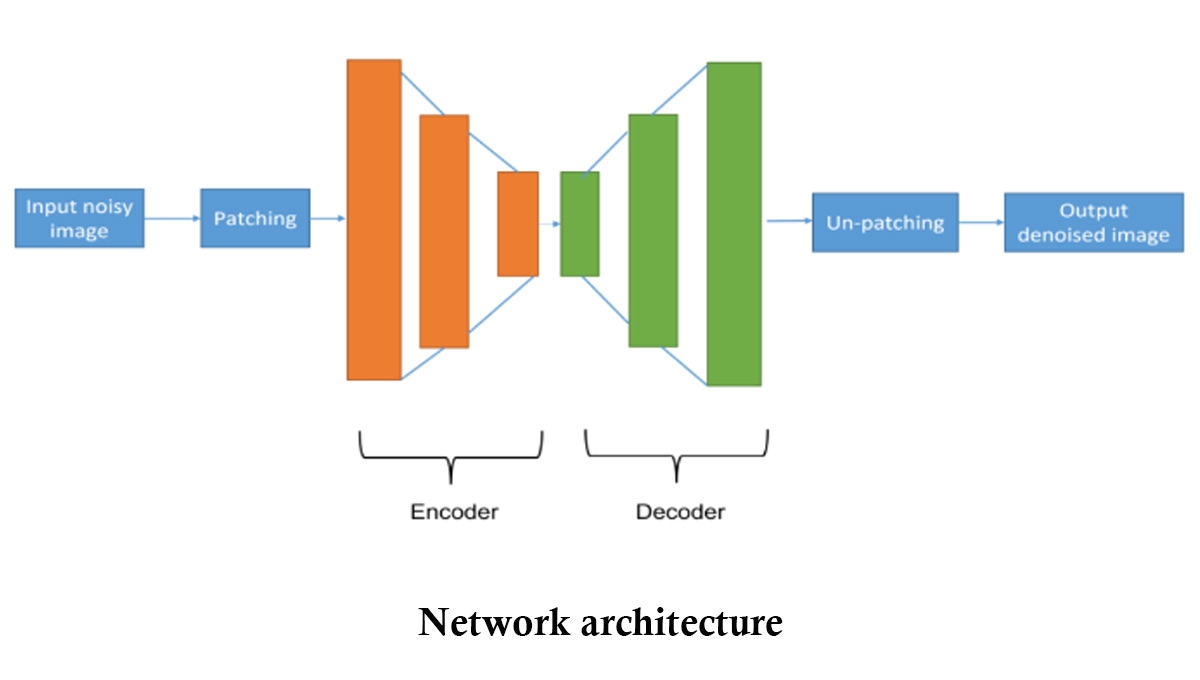 This paper proposes to use a deep-stacked under complete autoencoder to denoise the noisy 3D integral (sectional) images with a patch-based approach. In this process, the noisy input 3D sectional image is divided into multiple patches, which are then used to train the neural network. By using the patch-based approach, the time required to prepare the labeled training data is greatly reduced. Results demonstrate the feasibility of our proposed model in terms of the peak-signal-to-noise ratio.
This paper proposes to use a deep-stacked under complete autoencoder to denoise the noisy 3D integral (sectional) images with a patch-based approach. In this process, the noisy input 3D sectional image is divided into multiple patches, which are then used to train the neural network. By using the patch-based approach, the time required to prepare the labeled training data is greatly reduced. Results demonstrate the feasibility of our proposed model in terms of the peak-signal-to-noise ratio.
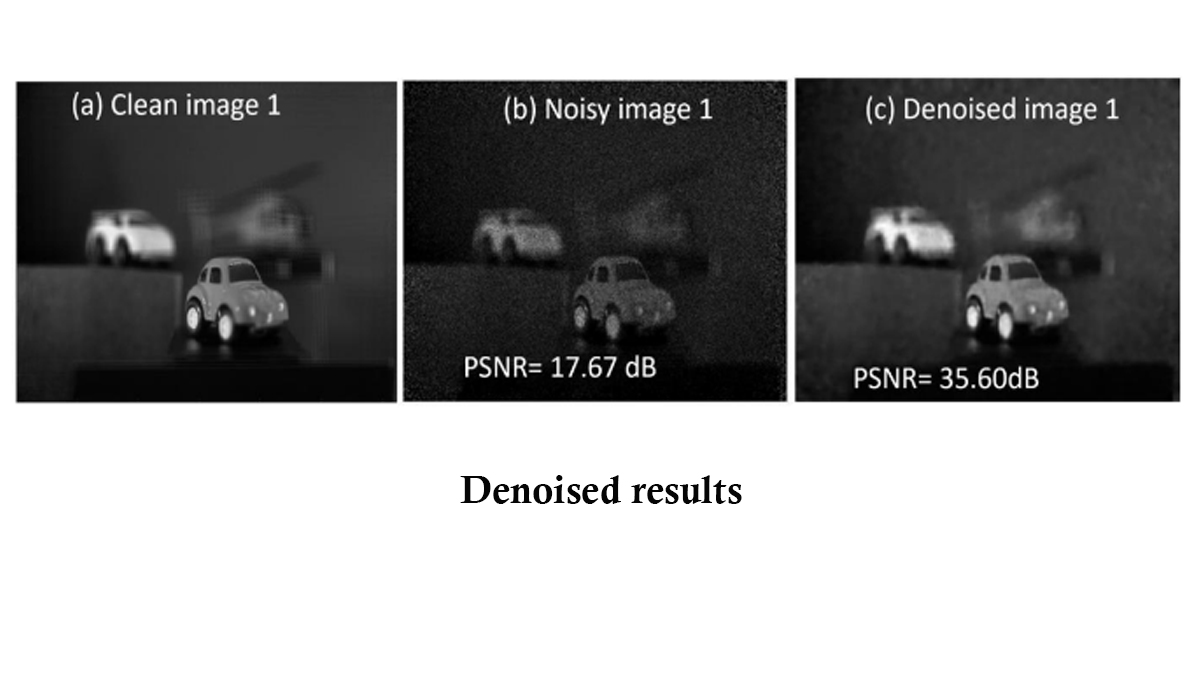 Explanation of the research
Explanation of the research
Denoising is one of the preliminary processes in image processing that removes noise from an image of interest and restores a clean image. The noise which was generated during the image acquisition process is attenuated using deep learning techniques. The denoised image is further used in various tasks of image processing.
In any image acquisition system, noise is inevitable and needs to be attenuated before further processing for qualitative results. The medical field is an example of this (images acquired through CT, MRI, PET, etc.). The researchers further investigate various techniques in deep learning to improve the denoising performance along with the applicability of deep learning in various tasks such as object recognition etc.
- Published in Departmental News, ECE NEWS, News, Research News
Pave your pathway to Ivy League Universities
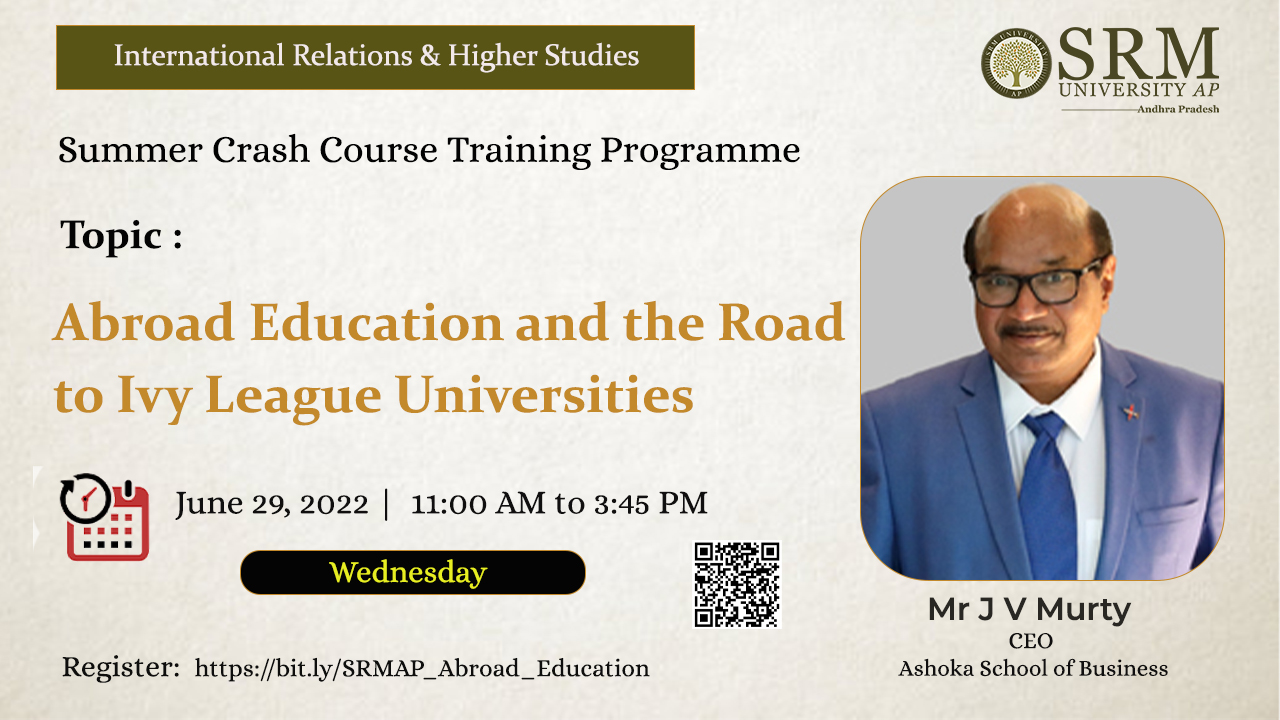
Have you ever been nervous at the thought of writing competitive exams? Have you ever tried tricks to get the better of such exams? It is very natural that students hold fear and dislike towards such tests as they were conditioned to believe that their future hangs at the mercy of an examination. Preparing for such standardised academic tests is a complicated process as one barely knows what to learn and where to start. But the more critical question is how to learn. A clear picture of how to learn and give their best shot at such tests will help smoothen their pathway.
The Office of International Relations and Higher Studies has scheduled a webinar on ‘Abroad Education and the Road to Ivy League Universities’ with Mr J V Murty as the keynote speaker. He will walk students through the learning process of different types of standardised tests to grab a great score and ease their pathway towards overseas education.
Date: June 29, 2022
Time: 11.00am to 3.45pm
About the Speaker
Mr J V Murty is one of the most revered educators in the field of training for competitive examinations and abroad education consulting in the country. He specialises in preparing students to ivy league universities in the USA and IIMs/ISB in India.
He is a gold medalist from NIT Rourkela. He worked for the Visakhapatnam Steel Plant and Siemens in West Germany. He served as Director for T.I.M.E for more than 20 years. He has also trained and sent more than 3000 students to different IIMs and prestigious Business Schools during this time.
He served as Vice-chairman for Woxsen University and is currently working as CEO at Ashoka School of Business.
He gave CAT 17 times and scored 100% 4 times. He also holds a 339 out of 340 in GRE and a 9 on 9 in IELTS.
Join the webinar with Mr J V Murty, the master trainer, and chart your path to the Ivy League Universities!
- Published in Events, International Relations, IR-Events
Embarking on a new journey with pride
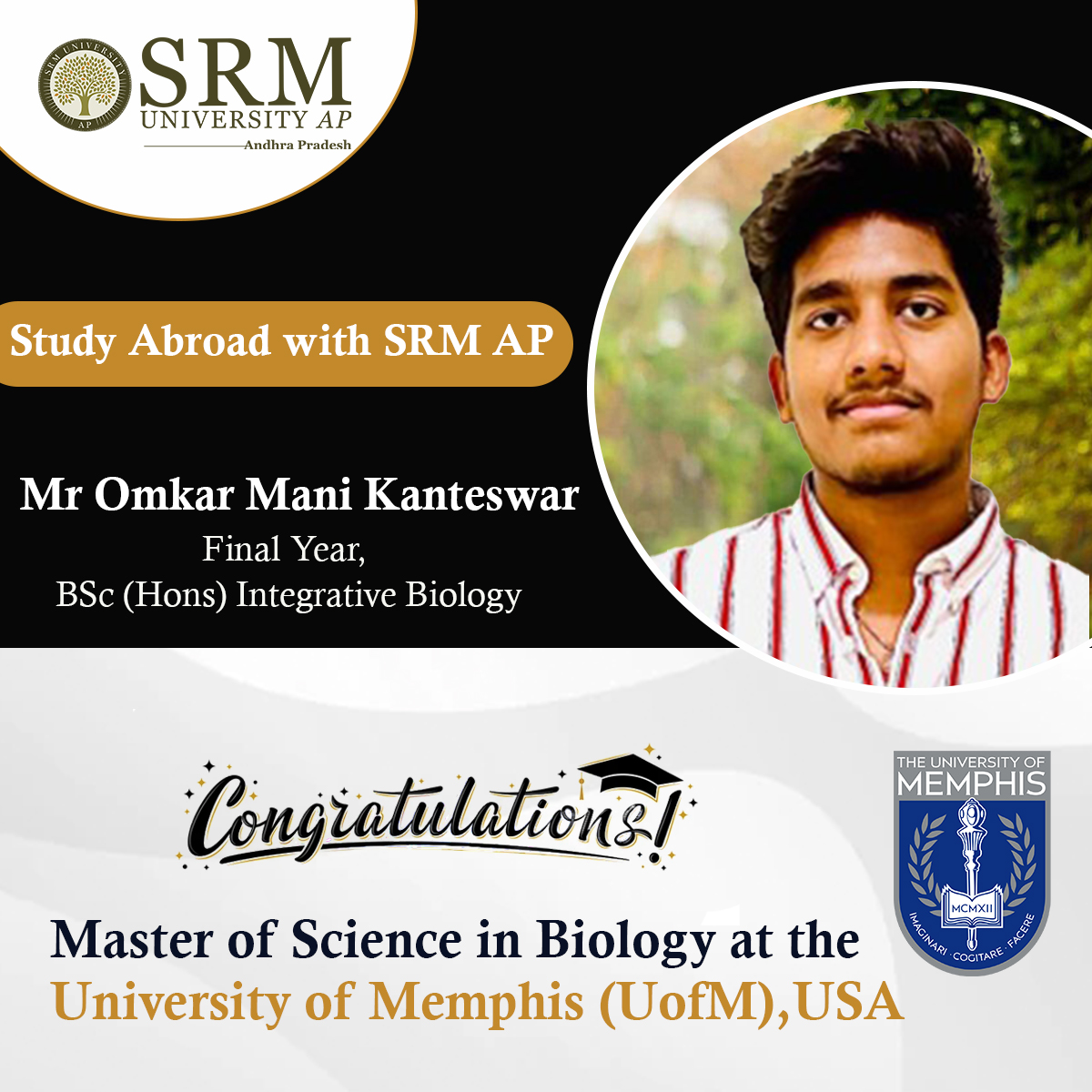 Final year BSc (Hons) Integrative Biology student Mr Omkar Mani Kanteswar has received an admission offer for the Master of Science in Biology at the University of Memphis (UofM), USA. Omkar’s happiness has no bounds as he really worked hard to get into his dream university.
Final year BSc (Hons) Integrative Biology student Mr Omkar Mani Kanteswar has received an admission offer for the Master of Science in Biology at the University of Memphis (UofM), USA. Omkar’s happiness has no bounds as he really worked hard to get into his dream university.
The University of Memphis is a public research university in Memphis, Tennessee. Since Omkar is from a Bsc Biology background, he wanted to continue in the same research field. While shortlisting the universities, he found this research-oriented college. He passed the Duolingo test and IELTS to get into this college.
The Master of Science (MS) in Biology is a research-centred degree programme with an intensive core and elective curriculum. Omkar opted for this course owing to the fact that he wanted to continue his research in the field of Biology. His message for the junior batches is to be confident and independent to make their own decisions and not run with the herd. He urges them to focus on holistic development and extracurricular activities. He is also ready to provide support to them if they need any.
He extended his gratitude to the faculty members who helped him a lot in the process by giving him confidence. He was glad to have them because they consistently and positively helped him in his academics and choosing various colleges. Faculty from the Department of Biological Sciences- Prof Jayaseelan Murugaiyan (HOD), Assistant Professor Sutharsan Govindarajan, and Prof Imran Pancha hold significant positions in Omkar’s career venture.
Admission to a reputed institute means a sense of pride, the joy of knowing you would study the best things with the best ones. Omkar believes that this is just the beginning, and he is yet to do a lot more things with his precious life.
- Published in Biology News, Students Achievements
Fascinating overseas internship in Germany with SRM AP
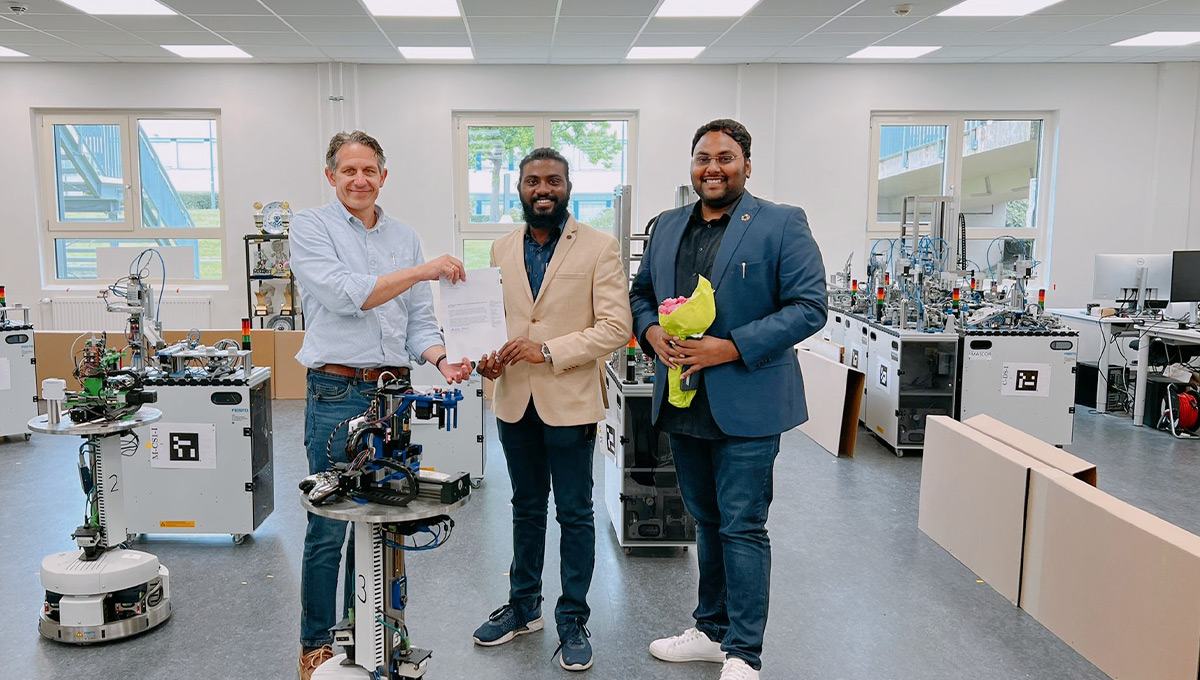 The results will be astonishing when hard work goes hand in hand with smart work. Vanteddu Nikhileswar from the Department of Mechanical Engineering at SRM University-AP preferred to believe in this strategy and has successfully completed an Internship and Project at MASCOR Institute in FH Aachen University, Germany.
The results will be astonishing when hard work goes hand in hand with smart work. Vanteddu Nikhileswar from the Department of Mechanical Engineering at SRM University-AP preferred to believe in this strategy and has successfully completed an Internship and Project at MASCOR Institute in FH Aachen University, Germany.
Nikhileswar got the opportunity to do an Internship and the International Project Exchange Programme at Mobile Autonomous Systems and Cognitive Robotics Institute through Indo Euro Synchronization (IES), an organisation providing educational and research programmes beyond borders. Even though affected by the Covid-19 restrictions, he completed the project and internship that lasted 6 months with an excellent quality of work.
Expert guidance
Under the guidance of Dr Alexander Ferrein, Director of MASCOR Institute, Nikhileswar worked on his project “Webots Simulation of Spot Robot for Rescue League”. The project’s target was to create a bezier curve, find the inverse kinematics for spot Robot and Robot programming in ROS, and develop a webots simulation for the spot Robot and Quadruped gait to improve the motion capabilities in the webots simulation environment.
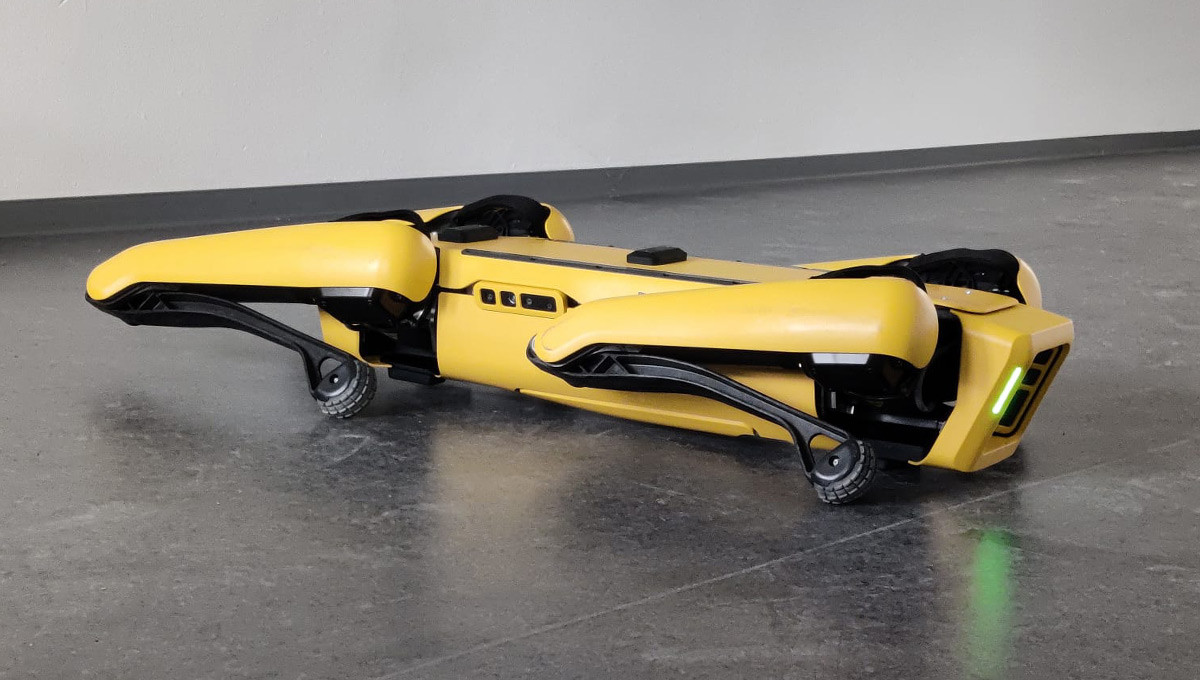
Priceless exposure
The skilled learning sessions with the scholars at the institute were a valuable addition to the career growth of Nikhileswar. While working in Germany, he was able to visit well-known companies and industries, which provided the opportunity to interact with many students and working professionals. This helped him to gain enormous clarity regarding different aspects of work opportunities and life as a whole.
Note of gratitude
He was thankful to the Indo Euro Synchronization President, Mr Venkat Raj, the management of SRM university-AP, Prof. Prakash Jadav, and Dr Pramod Jammy. The special guidance of Dr Starke, founder of MASCOR Institute, and Dr Alexander Ferrein, Director of MASCOR Institute FH Aachen University, holds a crucial role in his project work and internship.
Added accomplishment
Apart from the project, he has also secured admission at RWTH Aachen University for the Masters in Management and Engineering in Production Systems (MME-PS). This university ranks 147 Globally in QS Ranking 2023 and Ranks 19 QS World University Rankings by Subject 2022: Mechanical, Aeronautical & Manufacturing Engineering.
- Published in Blog, Departmental News, Engineering, Mechanical Engineering NEWS, News, Students Achievements, Technology


